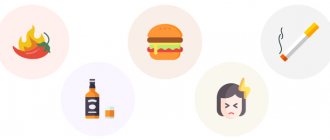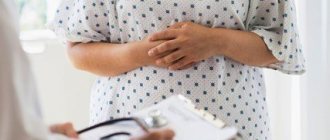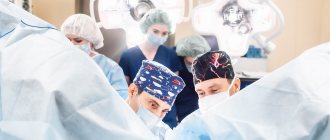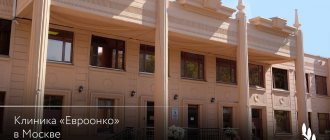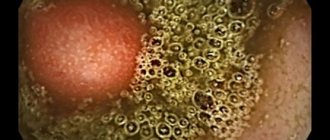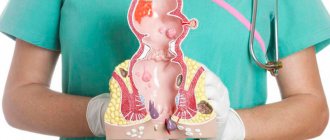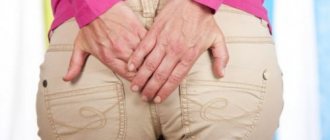There is an opinion that only adults or even older people suffer from hemorrhoids. In fact, this very unpleasant disease can develop at any age. In some cases, a hemorrhoidal nodule forms in childhood, causing pain and discomfort to the baby. There are two types of disease:
- Internal type. The lumps are located in the rectum and fall out of the anus after defecation.
- External type. Hemorrhoids appear around the anus.
The main thing a parent should do if such lumps are detected in a child is to seek medical help. Self-treatment can only aggravate the course of the disease, provoke blood loss or cause dangerous complications.
Hemorrhoids in a child: causes
Hemorrhoidal disease occurs in children of all ages, including those under 1 year of age. Negative factors that provoke the development of the disease include:
- Poor nutrition. Often, due to an unbalanced diet, the intestinal microflora is disrupted. Due to disturbances in the nutritional system, stool becomes harder, which increases blood flow to the vessels of the anus.
- Prolonged constipation. This provokes enlargement and damage to hemorrhoidal nodules.
- Constant crying. Prolonged crying increases the pressure inside the abdominal cavity, which causes problems with bowel movements.
- Congenital pathology of hemorrhoidal vessels. Pathology is rare.
In older children, including teenagers, the main reason for the development of hemorrhoids, as a rule, is a sedentary lifestyle. The number of children with this disease is only increasing. This is due to the fact that many teenagers spend their time not playing games on the street, but sitting at the computer or phone. Therefore, the task of parents is to ensure that the child moves as much as possible and does not sit in one place for a long time.
Complications of the disease
Against the background of this pathology, anal fissures appear quite often. Anemia may develop due to bleeding. In this case, the child will be lethargic and quickly lose weight. Serious complications include:
- thrombosis of external and internal nodes, which will lead to severe pain;
- at stages 3 and 4 necrosis develops;
- anal sphincter insufficiency;
- paraproctitis.
Pruzhinin Mark Yulievich
pediatrician
If parents do not respond to their child’s complaints in a timely manner, there is a high risk of complications. In this case, it is important to seek advice from specialists as soon as possible. Our doctors are ready to answer all questions, provide comprehensive information, and tell you a detailed plan of action for pathology.
Online consultation
The first signs of hemorrhoids in children
For a long time, even the most observant parent may not be aware of health problems in their child. The fact is that hemorrhoids do not manifest themselves for a long time, which is why there is no clinical picture. At the first stage of development of the disease, the baby experiences some discomfort and minor pain that appears during bowel movements. And hemorrhoids are noticeable only with the external type of the disease. Pronounced symptoms appear at stages 2-3 of the disease. The child exhibits the following signs:
- Itching in the anal area;
- Crying for no apparent reason;
- There are traces of blood in the stool;
- There is redness and induration around the anus;
- Painful sensations during bowel movements;
- Increase and loss of nodes that refill themselves.
At the third stage, the nodules fall out of the anus and no longer refill themselves. If left untreated, the situation will only get worse. At the fourth stage, there is a constant loss of bleeding nodes. This causes severe pain. To avoid this, you need to monitor the baby’s health and, in case of the slightest suspicion, consult a doctor.
When to see a doctor
You should not postpone going to the doctor if:
- Constipation lasts more than three weeks.
- During the act of defecation, the child cries.
- Bulges appear around the anus, especially if these bumps are painful or itchy.
Our clinic employs doctors of the highest category. Before starting treatment for hemorrhoids, they will make an accurate diagnosis (children's hemorrhoids should be differentiated from allergies, helminthiasis and a number of other diseases). And then, after qualified treatment, the mother will be taught how to organize the child’s life so that episodes of hemorrhoids do not recur.
Hemorrhoids in children: the dangers of lack of treatment
The lack of adequate treatment for hemorrhoids in children aggravates the course of the disease. This causes the following consequences:
- Swelling and an inflammatory reaction occurs in the anus. Because of this, the patient constantly experiences severe pain.
- Heavy bleeding, which results in a decrease in blood pressure.
- Pinching of hemorrhoids, which can cause death of nearby tissues.
- Purulent and inflammatory process in the rectal area.
In order not to bring the child to such a state, professional treatment is necessary. If you self-medicate, there can be dire consequences. There is also a risk of sepsis. To do this, you should contact our medical center. To treat hemorrhoids in children, we use modern techniques and expensive equipment.
Diagnosis of hemorrhoids
The diagnosis is made comprehensively based on examination and laboratory tests.
Diagnosis algorithm for internal hemorrhoids:
- examination of the perinatal area;
- palpation;
- anoscopy (examination of the anus up to 10 centimeters with a special anal speculum);
- rectoscopy (using a rectoscope to examine the condition of the rectum up to 25 centimeters from the anus);
- colonoscopy (endoscopic examination);
- irrigoscopy (x-ray examination).
External hemorrhoids are detected by visual inspection and palpation.
This pathology is differentiated from acute paraproctitis, neoplasms, and Crohn's disease. If bleeding occurs, sharp pain during defecation, or constipation, an anal fissure should be differentiated.
FAQ
What causes hemorrhoids in teenagers?
+
Hemorrhoids in adolescence are caused by prolonged sitting, poor diet, congenital pathology of veins and blood circulation, and due to heavy lifting. Hemorrhoids in a teenager are no different in development and treatment from those in an adult.
Can a baby have hemorrhoids?
+
Hemorrhoids in infants are very rare. The etiology is not fully understood, but there are predisposing factors such as constipation, dysbacteriosis, prolonged crying, and congenital weakness of the veins.
Is it possible to cure hemorrhoids in a child completely?
+
Doctors do not deny this possibility. To get rid of pathology in childhood, it is important to detect the pathology in a timely manner and follow the recommendations of a proctologist.
Should my child have an enema before visiting the doctor?
+
No specific measures are required to prepare for a visit to the proctologist. It is enough just to maintain personal hygiene. Enemas and abstaining from food for a certain period of time are only needed for deep examinations of the rectum.
Hemorrhoids: code according to ICD-10
The International Classification of Diseases, Tenth Revision (ICD-10) is a generally accepted coding system for medical diagnoses developed by WHO. Based on the changes made to it in January 2013, hemorrhoids are assigned the following codes:
- K64.0 – stage I hemorrhoids, without prolapse of nodes from the anal canal;
- K64.1 – stage II hemorrhoids (hemorrhoids, under the influence of increased pressure in the abdominal cavity, extend beyond the anal canal, after which they spontaneously retract into it);
- K64.2 – stage III hemorrhoids (hemorrhoids that fall out during tension require manual reduction);
- K64.3 – stage IV hemorrhoids (manual reduction of prolapsed hemorrhoids is impossible);
- K64.4 – residual hemorrhoidal skin marks of the anus;
- K64.5 – perianal venous thrombosis;
- K64.8 – specified other hemorrhoids;
- K64.9 – unspecified hemorrhoids.
Video from YouTube on the topic of the article:
What is an anal fissure?
Anal fissure is a disease of the rectum when the mucous membrane of the anal canal is damaged. It is expressed in the form of cracks or ulcers at the border where the skin and mucous membranes come into contact. The wound itself is small in length - about one centimeter. After hemorrhoids and paraproctitis, it is the most common complication among diseases of this group.
Most often, this pathology is accompanied by the presence of hemorrhoids.
Anal fissure is a disease of young women, as well as men with non-traditional sexual orientation.
Cold as a treatment method
Teenagers with hemorrhoids suffer from the same symptoms as adults. First of all, the child is bothered by itching and burning in the anus. When, as the disease progresses, the nodes become larger and become inflamed, bleeding of varying intensity and pain may occur.
Like adults, children can also quickly eliminate discomfort using cold lotions and compresses, or introducing ice suppositories into the anus for a few seconds. They are prepared from water or herbal infusions, poured into molds and frozen. The candle should be held for no more than 30 seconds so as not to cause intestinal spasms and other complications.
In the video in this article, Elena Malysheva and her guests on her program will popularly talk about the prevention of hemorrhoids.
In medicine, 20 years ago, cases of adolescent hemorrhoids were extremely rare. Typically, inflammation was diagnosed only in people over 40 years of age. Nowadays, it is no longer uncommon to diagnose hemorrhoids in teenagers. In this situation, the treatment of this disease becomes a pressing issue for parents.
Characteristics of the pathology
Treatment of anal fissures
Treatment of anal fissures should primarily be based on two postulates: strict adherence to diet and hygiene.
The diet should be aimed at eliminating constipation . It is recommended to eat plant fiber, cereals, fermented milk products, prunes, dried apricots, vegetables and fruits, and boiled beets. This diet, for the most part, provides soft stools.
Hygiene consists of constantly washing with cool water after going to the toilet.
In the presence of an acute stage of anal fissures, a proctologist uses a conservative method of treatment:
- medications are used - special suppositories, creams, ointments containing a local anesthetic. They are used after the patient has sat in a warm bath for 10-15 minutes.
- bath with herbal infusions and antiseptic solutions.
- drugs that normalize the functioning of the gastrointestinal tract, laxatives (in case of frequent constipation).
With timely and competent treatment, the disease usually resolves within 7-10 days.
When treating a chronic form of anal fissure , which has been observed in a patient for a month or more, more intensive treatment tactics are used - the affected area of the anus is removed.
IN HARMONY, removal of chronic anal fissure is performed using an innovative method - the Surgitron radio wave therapy device (USA) is used. With the help of equipment, the operation is quick and easy, but allows you to achieve good results.
Coagulation of anal fissures with radio waves is painless, without blood, without scars . The procedure is performed on an outpatient basis, in one doctor's visit. Complete healing occurs already on the 7th day. The patient does not require hospitalization.
The operation is over: recommendations for the treatment of anal fissure
After removal of anal fissures, you should follow the doctor’s recommendations:
- after each trip to the toilet, wash the anus with warm water (exclude the use of toilet paper)
- take sitz baths with an infusion of medicinal herbs or a solution of potassium permanganate
- adjust your diet: add fermented milk products to your diet, exclude fried, spicy, alcohol - use wound-healing suppositories or ointments as prescribed by your doctor.
- ensure that bowel movements are regular.
We hope that now when the question arises: “Does anal fissure require treatment?” You will answer with a clear “Yes!” and go to an outpatient appointment with an experienced proctologist. And our specialists will be happy to help you!
Types of anal fissures
Anal fissures are divided into acute and chronic.
The concept of acute anal fissures arose relatively recently. The pain is usually very sharp, but short-lived - no more than 20 minutes during and after bowel movement. For this type of anal fissure, surgery is generally not required. The disease is successfully treated with medications. If this type of crack is not treated, it becomes chronic.
Chronic anal fissures are characterized by the presence of thickened edges, scarring, and severe long-term pain. Pain appears not only after defecation, but also after changing body position. The so-called stool fear begins when the patient is afraid to change his body position. A thickened fold forms at the edge of the crack - a guard tubercle, which prevents the crack itself from healing safely. Over time, the scarring process can cause a narrowing of the anus. Also with this form, exposed sphincter muscle is observed.
The causes of anal fissure are varied:
- injuries to the rectal mucosa after defecation or as a result of anal sex, if the enema tip is inserted incorrectly;
- injuries received during childbirth;
- frequent constipation.
- disturbance of blood flow in the pelvis in people who spend a long time in a sitting position (sedentary work).
Anal fissures may also occur if you have the following diseases:
- haemorrhoids;
- anoproctitis;
- sphincteritis;
- anal condyloma;
- proctitis;
- colitis;
- dysentery;
- syphilis;
- leukemia;
- tuberculosis;
- HIV AIDS.
Prevention of anal fissure involves proper nutrition, avoiding alcohol and spicy foods, getting regular physical activity, and treating diseases associated with constipation.
Also follow these recommendations to prevent anal fissures:
- Don't sit on the toilet for a long time. If defecation does not occur within 10 minutes, postpone going to the toilet;
- do not hold back the urge to go to the toilet; empty your bowels while you go;
- lead a healthy lifestyle, play sports, walk more;
- If your job is sedentary, be sure to arrange physical training sessions.
Symptoms
The initial stage of the disease in children is practically asymptomatic. Signs of hemorrhoids begin to appear only as it progresses. These include:
- itching, burning and/or pain in the anus;
- feeling of incomplete emptying of the rectum;
- spotting during or immediately after bowel movements;
- the appearance of small protrusions around the anus.
Conservative therapy in children is carried out at home, but always as prescribed and under the supervision of a doctor.
Infection of hemorrhoids is accompanied by increased pain, a rapid increase in body temperature to febrile levels, and the appearance of symptoms of intoxication (headache and muscle pain, lack of appetite, weakness).
Usually only children aged 4 years and older can formulate complaints correctly and accurately. Young children inform others about their ailments through whims and crying. Therefore, in this case, to make a correct diagnosis, parents’ observation and ability to understand their baby is of great importance.

